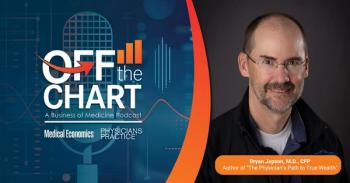
So You Want to be a Part-Time Physician?
Part-time employment can afford physicians greater work-life balance and a reprieve from burnout. Here's how to successfully transition.
Physician stress levels have reached epidemic proportions with nearly 55 percent reporting at least one symptom of burnout, according to a 2015 Mayo Clinic study, prompting healthcare leaders to declare it a public health crisis in
This tenuous environment may be one of the reasons why more than 63 percent of physicians would consider part-time employment,
For many physicians though, the definition of part-time may be anything but traditional. From a reduction in clinical hours to greater control over patient scheduling, part-time employment may not be defined solely by hours worked. More accurately, part-time means allowing more time and energy for self and family, the pursuit of hobbies and interests, and the exploration of tangential careers. Here are three examples of such arrangements and advice for physicians looking to do the same.
Locum tenens
Jacques Days, MD, a locum tenens family medicine physician with Consilium Staffing in Columbia, S.C., began working weekend locum positions in 2002 while still employed full-time at a community health clinic. He continued accepting shifts off and on for the next several years, using them to supplement his income during a sabbatical to pursue a pastoral degree in 2007. Shortly thereafter, Days accepted a pastoral position with a local church and ended his sabbatical, once again going back to juggling full-time practice and the occasional locum shifts along with his new position.
By 2013, Days was growing frustrated with the administrative burden and scheduling rigidity of full-time practice and decided to narrow his healthcare focus to locum tenens exclusively, first for a state mental health facility and then a state correctional facility a few years later. While his hours fluctuated significantly during this time, the primary benefit remained. "With locums, I've worked several different schedules - everywhere from two days to five days per week consistently - but the difference is that I choose when I work," said Days.
Now back in a community health setting and working approximately two days per week, Days has found that part-time employment allows him to maintain his professional skills, achieve work-life balance, and worry less about the business side of running a practice. While part-time employment may be difficult to achieve right out of medical school, he said it can be a worthwhile option for those who would like to pursue other career opportunities, need to tend to family obligations, or are struggling with burnout.
Days encourages locum tenens physicians to negotiate with their agency to ensure that malpractice insurance and tail coverage are provided. As an independent contractor, finding a simple way to document expenses and mileage can pay off big when tax time comes around also. "Plan, prepare, and gather information! Don't just jump into anything," says Days. "Seek information from colleagues who do locums, ask a lot of questions about any opportunity you are considering, and make sure the company aligns with your own vision and ideals."
Direct primary care
"If you know there is a better model for your life, and you can still make the same income and be available for your family and friends - who wouldn't want to do that?!" said Napoleon Maminta, DO, a primary care physician and founder of Naptown Priority Health, a direct primary care practice in Noblesville, Ind.
That thought pattern is what guided Maminta's decision to make the leap from traditional practice - where he saw upward of 30 patients per day, juggled an on-call commitment, and battled a nightly backlog of electronic charting work that intruded on time with his children - to direct primary care (DPC). Today, Maminta sees fewer than 10 patients per day, but spends at least 45 minutes with each one. With lower stress levels and improved autonomy, the membership-based fee structure allows him to focus on addressing the totality of patients' health issues instead of just one or two primary or acute concerns.
Beyond the patient care advantages, there are significant personal benefits as well. "There is no stress. I look forward to work, it's more fun, [and] it's [freed up] my weekends," says Maminta. "[During the week], I can leave later in the mornings [or] leave early and get home for dinner with [my] kids."
It's an alternate career pathway he encourages his colleagues and those coming out of medical school to contemplate. "Consider how much independence you want and how you want to practice medicine," Maminta said. "No doctor [goes] into medicine to injure people, so if you're burning out [or] in a situation that you don't want to do, it's time to move on."
While there are bound to be impediments that threaten to prevent or delay desired employment changes, Maminta says virtually all of these can be navigated with relative ease. Choosing to go into DPC avoided conflicts with his non-compete agreement, because it was considered different from his previous primary-care position. Malpractice costs, while not necessarily inexpensive, have still been manageable. To stay competitive and profitable, starting out with a low overhead has provided an enormous jumpstart.
"Find a small office space, hire a few people, buy your equipment as inexpensive as possible, let people know that you're there, and establish rapport with your patients," he said. "Yes, there are startup costs, but it's not bad. If you were in practice even for a short period of time [before DPC], your patients can find you and your practice can grow."
Academia administration
Stacey Pierce-Talsma, D.O., an osteopathic physician and associate professor and chair of osteopathic manipulative medicine at Touro University in Vallejo, Calif., has worked in academic medicine her entire career. In her former position at another university, she spent up to 60 hours each week seeing patients, precepting residents, lecturing, and performing administrative duties. Her transition to an administrative role at Touro University has cut her face-to-face patient time in half, shaved upward of 20 hours off her weekly schedule, and allowed her to focus on her primary interest of student engagement. The administrative aspect of Pierce-Talsma's responsibilities allows for a more fluid schedule - for example, attending a yoga class during work hours isn't usually a deal-breaker so long as she makes up the time elsewhere - and there is a considerable amount of flexibility during the summer.
"Being an academic physician isn't what I had planned when I first started medical school, but I'm so grateful to have found it," said Pierce-Talsma. "You can start in academic medicine slowly. At Touro, we have adjunct professors who teach in the doctoring skills and osteopathic medicine labs any range of days from a half day to several half days per week." In addition to pay, adjunct faculty can also benefit by counting teaching time toward at least a portion of continuing medical education requirements.
Similar opportunities may exist at residency programs and medical schools where a combination of teaching and mentorship are needed. If physicians want a trial run before making the leap, Pierce-Talsma suggests volunteering to conduct a lecture or series of lectures.
"Many physicians have started to decrease their hours and work part-time," she said. "[In academia medicine], there is increasing awareness of physician burnout [and] this has made it more acceptable to move to a part-time position where you can still be engaged with patient care and the practice of medicine while remaining cognizant of [personal] health and wellness needs."
Career and financial support
Whatever direction physicians take to work part-time hours, an employment change, whether temporary or permanent, can prompt concerns about career impact, finances, and even self-worth. To ease the transition, compiling a solid support team - from career coaches to financial planners to family and friends - can be helpful, experts say.
Career coaches can assist in identifying short- and long-term goals as well as potential employment pathways. Peter S. Moskowitz, a physician career and life coach and executive director of the Center for Professional & Personal Renewal, a consultancy for physician career transition and life coaching in Palo Alto, Calif., uses the four basic pillars of self-knowledge to ensure well-integrated career transitions for his clients. "A physician's personality profile, unique transferable skills, career values, and personal sense of purpose [can] provide a stable platform from which physicians can scout new and appropriate careers," he said.
When it comes to financial concerns, advanced planning is critical. With issues running the gamut from potential pay reductions and loss of benefits, to access to public service loan forgiveness programs that are based on full-time employment, forming a relationship with a trusted adviser even while still in medical school can lay the groundwork for future career transitions.
"I always dig to see if we can uncover [career] goals as early in the process as possible," says Daniel B. Wrenne, a certified financial planner and founder of Wrenne Financial Planning, a physician financial planning firm in Lexington, Ky. While a spouse's income and benefits can minimize the financial impact of part-time employment decisions, others making the transition may need to make significant lifestyle adjustments.
Given sufficient time to plan, a solution can often be found for many issues including cash flow and benefit availability. "Planning ahead is key. There are lots of things you can do to prepare like build up cash, pay off loans, and live off of one income," said Wrenne. "Several of our clients work [enough hours] to maintain full benefits." Otherwise, physicians may consider enrolling in their spouse's healthcare plan or purchasing private insurance.
Both the physician and their family members may feel significant stress and anxiety surrounding a potential loss of income or change in employment status. "The reduction in income can be highly threatening to spouses and other dependents [and] you will need their support and understanding," said Moskowitz. A certified financial planner may be able to identify a feasible financial pathway to ease these concerns and gain buy-in from all involved. Similarly, a career coach can walk physicians through the emotional baggage that frequently accompanies a career transition including changes in self-worth, confidence, and how colleagues view them.
While these adjustments take time and energy to work through, Moskowitz says the end result is well worth it: "Transitions to part-time practice are never easy, but always rewarding [and result in] greater self-reliance, personal and professional freedom, and emotional and physical wellness. Follow your intuition."
Steph Weber is a freelance writer hailing from the Midwest. She writes about healthcare, finance, and small business, but finds her passion for the medical field growing in sync with the ever-changing healthcare laws.
Newsletter
Optimize your practice with the Physicians Practice newsletter, offering management pearls, leadership tips, and business strategies tailored for practice administrators and physicians of any specialty.









